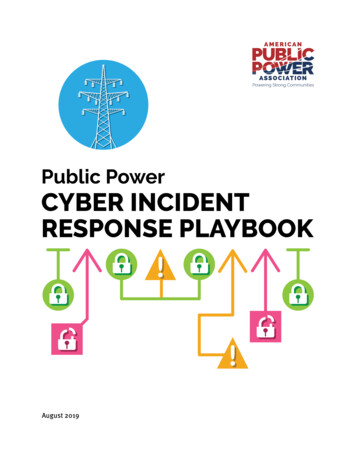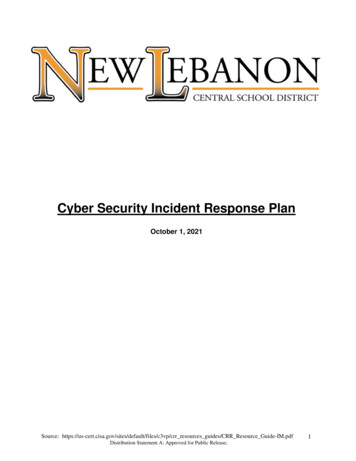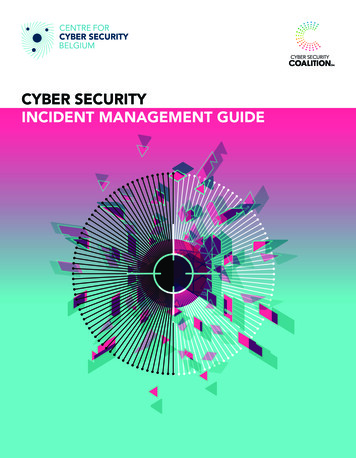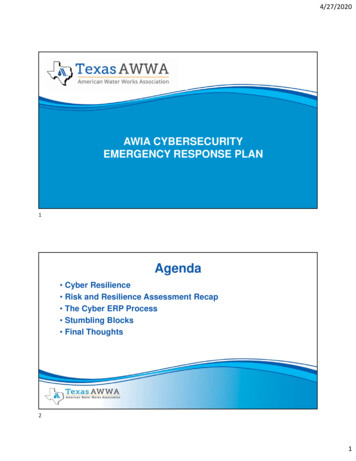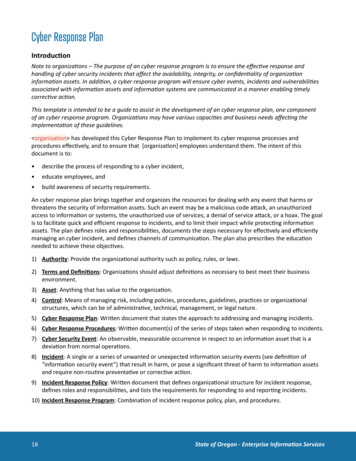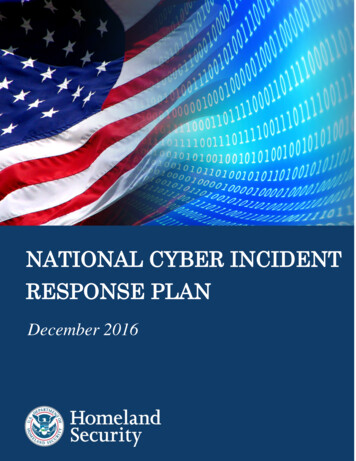
Transcription
National Cyber Incident Response PlanNATIONAL CYBER INCIDENTRESPONSE PLANDecember 2016PRE-DECISIONAL DRAFT
National Cyber Incident Response PlanThis page intentionally left blank.1
National Cyber Incident Response PlanTable of ContentsEXECUTIVE SUMMARY . 4INTRODUCTION. 6SCOPE . 6GUIDING PRINCIPLES . 7RELATIONSHIP TO NATIONAL PREPAREDNESS SYSTEM. 8ROLES AND RESPONSIBILITIES . 10CONCURRENT LINES OF EFFORT . 11THREAT RESPONSE . 12Private Sector. 12State, Local, Tribal, and Territorial Governments . 13Federal Government . 13ASSET RESPONSE. 14Private Sector. 14State, Local, Tribal, and Territorial Government . 16Federal Government . 17INTELLIGENCE SUPPORT . 19State, Local, Tribal, and Territorial Government . 19Federal Government . 20AFFECTED ENTITY’S RESPONSE . 21Cyber Incidents Involving Personally Identifiable Information . 21CORE CAPABILITIES . 21Access Control and Identity Verification . 22Cybersecurity . 22Forensics and Attribution . 22Infrastructure Systems. 23Intelligence and Information Sharing. 23Interdiction and Disruption . 23Logistics and Supply Chain Management . 24Operational Communications . 24Operational Coordination . 24Planning . 24Public Information and Warning. 25Screening, Search, and Detection . 25Situational Assessment . 25Threats and Hazards Identification . 25COORDINATING STRUCTURES AND INTEGRATION . 26COORDINATING STRUCTURES . 26Private Sector. 26State, Local, Tribal, and Territorial Governments . 27Federal Government . 28International . 29OPERATIONAL COORDINATION DURING A SIGNIFICANT CYBER INCIDENT . 29Determination of Incident Severity . 29Enhanced Coordination Procedures . 31Cyber UCG . 31Information Sharing During Cyber Incident Response . 342
National Cyber Incident Response PlanCONCLUSION . 34ANNEX A: AUTHORITIES AND STATUTES. 36ANNEX B: CYBER INCIDENT SEVERITY SCHEMA. 38ANNEX C: CYBER INCIDENT SEVERITY SCHEMA/ NATIONAL RESPONSECOORDINATION CENTER ACTIVATION CROSSWALK . 39ANNEX D: REPORTING CYBER INCIDENTS TO THE FEDERAL GOVERNMENT . 40ANNEX E: ROLES OF FEDERAL CYBERSECURITY CENTERS . 43ANNEX F: CORE CAPABILITIES AND CRITICAL TASKS . 45ANNEX G: DEVELOPING AN INTERNAL CYBER INCIDENT RESPONSE PLAN . 53ANNEX H: CORE CAPABILITY/NIST CYBERSECURITY FRAMEWORK/PPD-41CROSSWALK. 54ANNEX I: ADDITIONAL RESOURCES . 59ANNEX J: ACRONYM LIST. 603
National Cyber Incident Response PlanExecutive SummaryNetworked technologies touch every corner of the globe and every facet of human life. They havedriven innovation, nurtured freedoms, and spurred economic prosperity. Even so, the verytechnologies that enable these benefits offer new opportunities for malicious and unwanted cyberactivities. The risks associated with the Nation’s dependence on these networked technologies led tothe development of Presidential Policy Directive 41 (PPD-41): United States Cyber IncidentCoordination, which sets forth principles governing the Federal Government's response to any cyberincident, whether involving government or private sector entities.PPD-41 recognizes that the frequency of cyber incidents is increasing, and this trend is unlikely to bereversed anytime soon. The most significant of these incidents, those likely to result in demonstrableharm to the national security interests, foreign relations, or economy of the United States or to thepublic confidence, civil liberties, or public health and safety of the American people, necessitatedeliberative planning, coordination, and exercising of response activities, in order to minimize thethreat and consequences to the Nation, infrastructure, and way of life.The National Cyber Incident Response Plan (NCIRP or Plan) was developed according to thedirection of PPD-41 and leveraging doctrine from the National Preparedness System to articulate theroles and responsibilities, capabilities, and coordinating structures that support how the Nationresponds to and recovers from significant cyber incidents posing risks to critical infrastructure. TheNCIRP is not a tactical or operational plan; rather, it serves as the primary strategic framework forstakeholders to understand how federal departments and agencies and other national-level partnersprovide resources to support response operations. Authored in close coordination with governmentand private sector partners, the NCIRP expounds upon the concurrent lines of effort, defined by PPD41, for how the Federal Government will organize its activities to manage the effects of significantcyber incidents. The concurrent lines of effort are threat response, asset response, intelligencesupport, and the affected entity, which undertakes efforts to manage the effects of the incident on itsoperations, customers, and workforce. The activities and lead federal agencies for each line of effortwithin the Cyber Unified Coordination Group are described below. The Department of Justice is the lead agency for threat response during a significant cyberincident, acting through the Federal Bureau of Investigations and National Cyber InvestigativeJoint Task Force. Threat response activities include conducting appropriate law enforcement andnational security investigative activity at the affected entity's site; collecting evidence andgathering intelligence; providing attribution; linking related incidents; identifying additionalaffected entities; identifying threat pursuit and disruption opportunities; developing andexecuting courses of action to mitigate the immediate threat; and facilitating information sharingand operational coordination with asset response. The Department of Homeland Security is the lead agency for asset response during a significantcyber incident, acting through the National Cybersecurity and Communications IntegrationCenter. Asset response activities include furnishing technical assistance to affected entities toprotect their assets, mitigate vulnerabilities, and reduce impacts of cyber incidents; identifyingother entities that may be at risk and assessing their risk to the same or similar vulnerabilities;assessing potential risks to the sector or region, including potential cascading effects, anddeveloping courses of action to mitigate these risks; facilitating information sharing and4
National Cyber Incident Response Planoperational coordination with threat response; and providing guidance on how best to utilizefederal resources and capabilities in a timely, effective manner to speed recovery. Threat and asset responders will share some responsibilities and activities, which may includecommunicating with affected entities to understand the nature of the cyber incident; providingguidance to affected entities on available federal resources and capabilities; promptlydisseminating through appropriate channels intelligence and information learned in the course ofthe response; and facilitating information sharing and operational coordination with other FederalGovernment entities. The Office of the Director of National Intelligence is the lead coordinator for intelligence supportduring a significant cyber incident, acting through the Cyber Threat Intelligence IntegrationCenter. Intelligence support and related activities include providing support to federal asset andthreat agencies and facilitate the building of situational threat awareness and sharing of relatedintelligence; the integrated analysis of threat trends and events; the identification of knowledgegaps; and the ability to degrade or mitigate adversary threat capabilities. An affected federal agency shall engage in a variety of efforts to manage the impact of a cyberincident, which may include maintaining business or operational continuity; addressing adversefinancial impacts; protecting privacy; managing liability risks; complying with legal andregulatory requirements (including disclosure and notification); engaging in communicationswith employees or other affected individuals; and dealing with external affairs (e.g., media andcongressional inquiries). The affected federal agency will have primary responsibility for this lineof effort. When a cyber incident affects a private entity, the Federal Government typically will not play arole in this line of effort, but it will remain cognizant of the affected entity's response activities,consistent with the principles above and in coordination with the affected entity. The relevantsector-specific agency will generally coordinate the Federal Government's efforts to understandthe potential business or operational impact of a cyber incident on private sector criticalinfrastructure.The NCIRP builds upon these lines of effort to illustrate a national commitment to strengthening thesecurity and resilience of networked technologies and infrastructure. This Plan outlines the structureand content from which stakeholders can leverage to inform their development of agency-, sector-,and organization-specific operational response plans. Correspondingly, this Plan should beunderstood to be a living document, to be updated as needed to incorporate lessons-learned, to reflectopportunities and challenges that arise as technology evolves, and to ensure the Plan adequatelyaddresses a changing threat/hazard environment.5
National Cyber Incident Response PlanIntroductionThe National Cybersecurity Protection Act of 2014 (NCPA) 1 consequently codified in the HomelandSecurity Act 2, mandates that the Department of Homeland Security (DHS), in coordination withappropriate entities and individuals, develop, regularly update, maintain, and exercise adaptablecyber incident response plans to address cybersecurity risks to critical infrastructure. PresidentialPolicy Directive (PPD)-41: U.S. Cyber Incident Coordination and the associated Annex, 3 set forthprinciples governing the Federal Government’s response to any cyber incident, provide anarchitecture for coordinating the response to significant cyber incidents, and required DHS todevelop a National Cyber Incident Response Plan (NCIRP or Plan) to address cybersecurity risks tocritical infrastructure. The NCIRP is part of the broader National Preparedness System andestablishes the strategic framework and doctrine for a whole-of-Nation 4 approach to mitigating,responding to, and recovering from a cyber incident. This approach includes and strongly relies onpublic and private partnerships to address major cybersecurity risks to critical infrastructure. Response Plan Purpose and Organization – The NCIRP provides guidance to enable acoordinated whole-of-Nation approach to response activities and coordination with stakeholdersduring a significant cyber incident impacting critical infrastructure. The NCIRP sets commondoctrine and a strategic framework for national, sector, and individual organization cyberoperational plans. Intended Audience – The intended audience for the NCIRP is U.S. organizations. However, itmay also enhance our international partners’ understanding of the U.S. cyber incidentcoordination. This whole-of-Nation concept focuses efforts and enables the full range ofstakeholders—the private and nonprofit sectors (including private and public owners andoperators of critical infrastructure), state, local, tribal, territorial (SLTT) governments, and theFederal Government—to participate and be full partners in incident response activities.Government resources alone cannot meet all the needs of those affected by significant cyberincidents. All elements of the community must be activated, engaged, and integrated to respondto a significant cyber incident.ScopeCyber incident response is an important component of information and communications technology(ICT) and operational technology programs and systems. Performing incident response effectively isa complex undertaking and requires substantial planning and resources to establish a successfulincident response capability.The NCIRP is the strategic framework for operational coordination among federal and SLTTgovernments, the private sector, and international partners. Developed according to the guidingprinciples outlined in PPD-41 and leveraging doctrine from the National Preparedness System and1The National Cybersecurity Protection Act of 2014. Public Law 113-282. December 18, PLAW-113publ282.pdf.26 U.S.C § 1493PPD-41: U.S. Cyber Incident Coordination. ber-incident; Annex for Presidential Policy Directive-41--United States CyberIncident Coordination, tes-cyber-incident.4The whole-of-Nation approach also encompasses a wide range of new and existing public and private partnershipsto leverage as a platform in working towards managing cybersecurity threats and hazards to critical infrastructure.6
National Cyber Incident Response Planthe National Incident Management System (NIMS), 5 the NCIRP sets the strategic framework for howthe Nation plans, prepares for, and responds to cyber incidents by establishing an architecture forcoordinating the broader community response during a significant cyber incident in accordance withU.S. law and policy. A list of authorities is found in Annex A: Authorities and Statutes. The NCIRPis also designed to integrate and interface with industry standards and best practices for cybersecurityrisk management, as developed by the National Institute of Standards and Technology’s (NIST)Framework for Improving Critical Infrastructure Cybersecurity. 6The NCIRP is not a tactical or operational plan for responding to cyber incidents. However, it shouldserve as the primary strategic framework for stakeholders when developing agency-, sector-, andorganization-specific operational plans. This Plan will help those affected by cyber incidentsunderstand how federal departments and agencies and other national-level partners provide resourcesto support SLTT and private sector response operations. It should also serve as the basis for nationalcyber operational playbooks and individual critical infrastructure sector operational coordinationplans, as well as be referenced by individual entities in their own plan development. In all cases,incident response activities will be conducted in accordance with applicable law and policy.Guiding PrinciplesThe NCIRP is based on several guiding principles outlined in PPD-41 for the response to any cyberincident, whether involving government or private sector entities. These principles include: Shared Responsibility. Individuals, the private sector, and government agencies have a sharedvital interest and complementary roles and responsibilities in protecting the Nation frommalicious cyber activity and managing cyber incidents and their consequences. Risk-Based Response. The Federal Government will determine its response actions and theresources it brings to bear based on an assessment of the risks posed to an entity, our nationalsecurity, foreign relations, the broader economy, public confidence, privacy and civil liberties, orthe public health and safety of the American people. Critical infrastructure entities also conductrisk-based response calculations during cyber incidents to ensure the most effective and efficientutilization of resources and capabilities. Respecting Affected Entities. To the extent permitted under law, Federal Government responderswill safeguard details of the incident, as well as privacy, civil liberties, and sensitive privatesector information, and generally will defer to affected entities in notifying other affected privatesector entities and the public. In the event of a significant cyber incident where the FederalGovernment interest is served by issuing a public statement concerning an incident, federalresponders will coordinate their approach with the affected entities to the extent possible. Unity of Governmental Effort. Various government entities possess different roles,responsibilities, authorities, and capabilities that can all be brought to bear on cyber incidents.These entities must coordinate efforts to achieve optimal results. The first federal agency tobecome aware of a cyber incident will rapidly notify other relevant federal agencies to facilitate aunified federal response and ensure that the right combination of agencies responds to aparticular incident. When responding to a cyber incident in the private sector, unity of effortsynchronizes the overall federal response, which prevents gaps in service and duplicative efforts.SLTT governments also have responsibilities, authorities, capabilities, and resources that can be5NIMS. ystem.Framework for Improving Critical Infrastructure Cybersecurity, version 1.0. National Institute of Standards andTechnology, February 12, 2014. 67
National Cyber Incident Response Planused to respond to a cyber incident; therefore, the Federal Government must be prepared topartner with SLTT governments in its cyber incident response efforts. The transnational nature ofthe Internet and communications infrastructure requires the United States to coordinate withinternational partners, as appropriate, in managing cyber incidents. Enabling Restoration and Recovery. Federal response activities will be conducted in a manner tofacilitate restoration and recovery of an entity that has experienced a cyber incident, balancinginvestigative and national security requirements, public health and safety, and the need to returnto normal operations as quickly as possible.While steady-state activities and the development of a common operational picture are keycomponents of the NCIRP, the Plan focuses on building the mechanisms needed to respond to asignificant cyber incident. Table 1 below describes the difference between a “cyber incident” and a“significant cyber incident” as outlined in PPD-41. The Federal Government uses the Cyber IncidentSeverity Schema (detailed in Annex B: Cyber Incident Severity Schema) to describe the incidentlevel, the process to determine the severity of an incident, and the threshold for designating asignificant cyber incident affecting the United States or its interest abroad. The United StatesComputer Emergency Readiness Team (US-CERT) website also provides a list of types of commonways cyber incidents can occur and exploit information and assets. 7Table 1: Cyber Incident Definitions from PPD-41IncidentDefinitionCyber IncidentAn event occurring on or conducted through a computer network thatactually or imminently jeopardizes the confidentiality, integrity, oravailability of computers, information or communications systems ornetworks, physical or virtual infrastructure controlled by computers orinformation systems, or information resident thereon.Significant Cyber IncidentA cyber incident that is (or group of related cyber incidents that togetherare) likely to result in demonstrable harm to the national securityinterests, foreign relations, or economy of the United States or to thepublic confidence, civil liberties, or public health and safety of theAmerican people.Relationship to National Preparedness SystemWhile the NCIRP focuses on cyber incident response efforts, the National Preparedness Systemoutlines a broader architecture that establishes how the broader community 8 prevents, protectsagainst, mitigates, responds to, and recovers from all threats and hazards. Specifically, the tion-guidelines#attack-vectors-taxonomyThe Response Federal Interagency Operational Plan, Second Edition, August 2016, describes the wholecommunity and includes all individuals and household members, specifically inclusive of people with disabilities,children, older Americans, people with different levels of language English proficiency, communities, the privateand nonprofit sectors, faith-based organizations, and local, state, tribal, territorial, insular area, and the FederalGovernment—and the Nation as a whole. 112507e23ad4d85449ff131c2b025743101/Response FIOP 2nd.pdf88
National Cyber Incident Response PlanResponse Framework (NRF) 9 sets the doctrine and provides guidance for how the Nation builds,sustains, and delivers the response core capabilities identified in the National Preparedness Goal. 10To further connect the NCIRP with the NRF, the Homeland Security Act 11 states the Secretary ofDHS, in coordination with the heads of other appropriate federal departments and agencies, and inaccordance with the NCIRP under that Act, shall regularly update, maintain, and exercise the CyberIncident Annex to the NRF of the Department. The NCIRP leverages the doctrine, capabilities, andorganizing structures of the NRF, and both the NRF and NCIRP structures align with NIMS asdescribed below.NIMS provides the common language and incident management structure for government at alllevels (federal and SLTT) and the private sector, and defines standard command and managementstructures. Successful response efforts, including cyber incident responses, depend on a common,interoperable approach for sharing resources, coordination, and communicating information. NIMSdefines this comprehensive approach and enables the whole-of-Nation12to work together to prevent,protect against, mitigate, respond to, and recover from the effects of incidents regardless of cause,size, location, or complexity.All of the components of the NIMS—resource management, management and coordination, andcommunications and information management—provide a common framework by whichjurisdictions and organizations, which vary in authorities, management structures, communicationcapabilities, and protocols, integrate with one another to achieve common goals. These concepts canalso apply to cyber incident response, in that they address: The development of a single set of incident objectives; The use of a collective, strategic approach to incident management; The improvement of information flow and coordination; The creation of a common understanding of joint priorities and limitations; The need to maintain an agency’s legal authorities; and The optimization of the combined efforts of all participants in the incident.The NRF also includes 14 Emergency Support Functions (ESF) 13; these federal coordinatingstructures group resources and capabilities into functional areas that are most frequently needed in anational response. ESFs are an effective way to bundle and manage resources to deliver the corecapabilities outlined in the NRF. These ESFs bring together the capabilities of federal departmentsand agencies and other national-level assets to support incident response. The ESFs are not based on9The NRF is one of five frameworks in the National Preparedness System; it describes how the whole communityworks together to achieve the National Preparedness Goal within the Response mission l.116 U.S.C. § 14912The National Preparedness System refers to whole community vs the NCIRP describing a whole-of-Nationapproach because of the nature of cyber infrastructure and associated incidents. The guidance, programs, processes,and systems that support each component of the National Preparedness System enable a collaborative, wholecommunity approach to national preparedness that engages individuals, families, communities, private and nonprofitsectors, faith-based organizations, and all levels of government. 55-25045-8110/national preparedness system ss-resource-library.9
National Cyber Incident Response Planthe capabilities of any single department or agency but are groups of organizations that work togetherto support an effective response.Activation of the
develop a National Cyber Incident Response Plan (NCIRP or Plan) to address cybersecurity risks to critical infrastructure. The NCIRP is part of the broader National Preparedness System and establishes the strategic framework and doctrine for a whole-of-Nation. 4. approach to mitigating, responding to, and recovering from a cyber incident.
